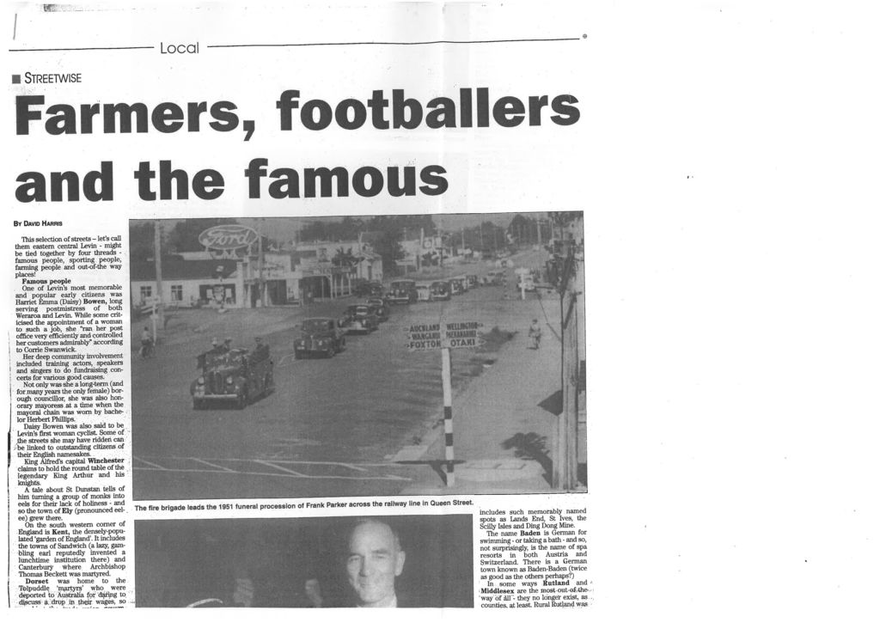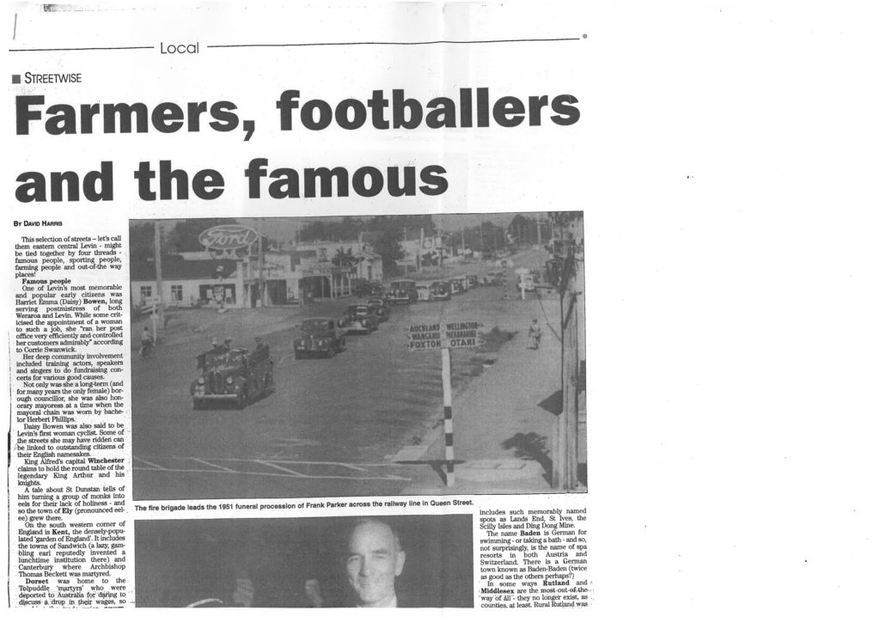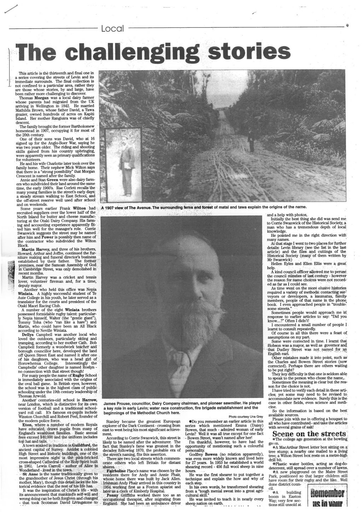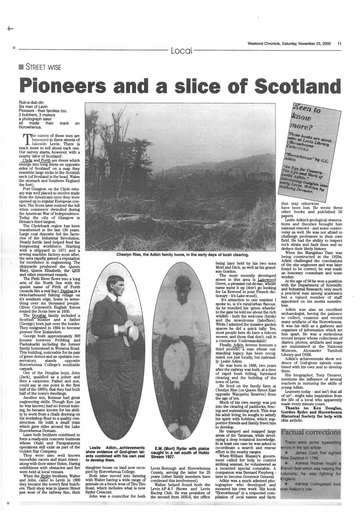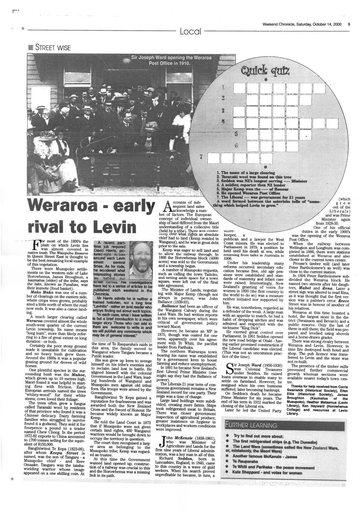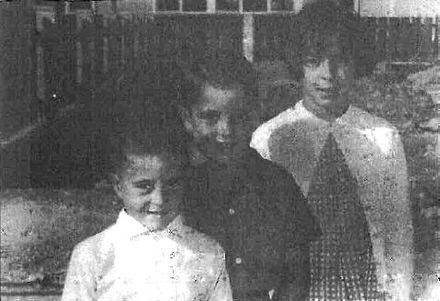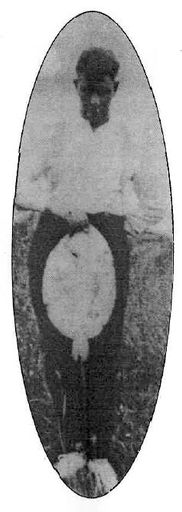Farmers, footballers and the famous
- Description
BY DAVID HARRIS
This selection of streets — let's call them eastern central Levin - might be tied together by four threads - famous people, sporting people, farming people and out-of-the Way place's! Famous people . One of Levin's most memorable and popular early citizens was Harriet Emma (Daisy) Bowen, long serving postmistress of both Weraroa and Levin. While some criticised the appointment of a woman to such a job, she "ran her post office very efficiently and controlled her customers admirably" According to Corrie Swanwick. Her deep community involvement . included training . actors, speakers and singers to do fundraising con-certs for various good causes. Not only was she a long-term (and for many years the only female) borough councilor; she was also honorary mayoress at a time when the mayoral chain was worn by bachelor Herbert Phillips.
Daisy Bowen was also said to be Levin's first woman cyclist Some of the streets she may have ridden can be linked to outstanding citizens of their English namesakes.
King Alfred's capital Winchester claims to hold the round table of the legendary King Arthur and his knights.
A tale about St Dunstan tells of him turning a group of monks into eels for their lack of holiness and so the town of Ely (pronounced eel-ee) grew there. On the south western corner of England is Kent, the densely-populated 'garden of England'. It includes the towns of Sandwich (a lazy, gambling earl reputedly invented a lunchtime institution there) and Canterbury where Archbishop Thomas Beckett was martyred. Dorset was home to the - Tolpuddle ‘martyrs' who were deported to Australia for 'daring to discuss a drop in their wages, so sparking the trade union government in Britain. Cambridge University hosted researchers such as New Zealander Ernest Rutherford who "opened the door" of the atom; and the teams who discovered the intricacies of proteins and DNA. Another Cambridge phenomenon is 'punt-bombing': students jump off little bridges (over the River Cam) trying to soak - and preferably jettison - the occupants of tiny leisure craft. Sport this may be to some — but Soccer is far more popular in England.Picture: The fire brigade leads the 1951 funeral procession of Frank Parker across the railway line in Queen Street.
includes such memorably named spots as Lands End, St Ives, the Scilly Isles and Ding Dong Mine. The name Baden is German for swimming - or taking a bath - and so, not surprisingly, is the name of spa resorts in both Austria and Switzerland. There is a German town known as Baden-Baden (twice as good as the others perhaps?) In some ways Rutland and Middlesex are the most out of the way of all - they no longer exist, as counties, at least. Rural Rutland was [famous for the 'Tolpuddle martyrs' who were deported to Australia for daring to discuss a drop in their wages, so sparking the trade union government in Britain. Cambridge University hosted researchers such as New Zealander Ernest Rutherford who "opened the door" of the atom; and the teams who discovered the intricacies of proteins and DNA. Another Cambridge phenomenon is 'punt-bombing': students jump off little bridges (over the River Cam) trying to soak - and preferably jettison - the occupants of tiny leisure craft. Sport this may be to some — but Soccer is far more popular in England.
Sporting people
In the round-ball game Highbury is synonymous with the home ground of the Arsenal team, whose greatest moments have been their 'double' seasons (twice in the last thirty years) when they have won both the championship and FA Cup in the one year. Geographically the name applies to the north London suburb where they are based, which centuries ago was dominated by a notable manor. Few would hear of the city of Manchester without thinking also of their most famous football team: United. They were the first English team to become champions of Europe in 1968 and they have been overwhelmingly the most successful club in the country during the 1990s. Other claims to the city’s significance are its role as a bustling industrial centre, a major international airport and a thriving culture venue. In an earlier century Frederich Engles cited it as an example of the evils of capitalism.Nearby Liverpool on the River Mersey is Britain’s econd-largest port and the birthplace of the Beatles. It too, is home of another reknownd team (Everton fans would say two!). As a 30 year supported of the Liverpool team (even before their great successes of the 1890s) I was delighted to see the city’s importance recognized in a major artery of our town – until I realised that the street’s major feature was a hospital pass.
Soccer followers who live around the River Tyne in north-east England tend to support the Newcastle United team – nicknamed the Magpies – who play in black and white.
Perhaps they are coalminers colours – the surrounding region has produced coal for over 600 years.
Horse racing, too, claims large following which includes British royalss – they traditionally attend the scot meeting. The Derby- race at Le Epsom course is also a popular Derby of course is also a Midlands county renowned for rail and aircraft engineering.)
Levin 's sport lovers owe a debt of thanks to Frank Ernest Parker - and course the generous former-owner Henry Playford - for the establishment of the expansive Playford Park.
 Picture: On left: Frank Parker and Mr T G Vincent, business partners who were merchants.
Picture: On left: Frank Parker and Mr T G Vincent, business partners who were merchants.Frank Parker and his wife Jessie, who was a daughter of pioneer sawmiller Richard and Christina Prouse.(need to get copy from Chronicle archives.
A keen bowler and golfer himself, Frank Parker served on the borough council for over thirty-three years. He was acknowledged as a man of farsightedness and zeal for his work in ensuring a quality gas supply for the town.
With Tom Vincent he operated a grain and general store on the corner of Bath and Oxford Streets (where Public Trust is today); customers had access to insurance, valuation and land agency services under the same roof. He chaired the fire board, among many Committee involvements. His approach was marked by a readiness to speak his mind and a close monitoring of council spending.Farming people
 Another man active in community leadership was Phillip Wharton Goldsmith. He left his Gisborne paddocks to take on a new role at the Central Development farm (from which the name CD Farm Road comes).
Another man active in community leadership was Phillip Wharton Goldsmith. He left his Gisborne paddocks to take on a new role at the Central Development farm (from which the name CD Farm Road comes).His grandson, Phil Goldsmith remembers hearing of a lively cow, which the others couldn’t control.
“Untie her and I’ll show you how!” said the old hand – and he did.
When he served later as town clerk, county clerk and power board secretary, he became known for his oderlyness and thoroughness. These qualities suited him well for his role at mayor from 1932 -1941. The land on which long-time resident Joe Cottle milked cows, was bought by Irishman Joe Quinn who had been a South Island ploughman just before the outbreak of the World War. On seeing the imminence of his conscription into the service of an English king, he made plans to avoid it - he joined the police force. The irony of this alternative service to the sovereign was not lost on his daughter Therese Ryder. For most of his working life Joe Quinn was a publican and on his retirement to Levin he built stables and trained racehorses.Lancashireman 'George Astridge also farmed dairy cows on his own fifteen - acre block. He had the title of Noble Grand as leader of the first Manchester Unity friendly society here: His fellow countrymen in the low lying country of Norfolk are known for a wide range of farming produce – from turkeys to barley.
Picture: PhilipGoldsmith, mayor of Levin 1932-41 with his wife Catherine.
Dover is the World's -busiest passenger harbour - despite the, 1994 completion of the nearby Channel tunnel (Chunnel), to France, The Lonely Planet Guidebook says, the Dover, foreshore is "basically an, enormous, complicated (though well-signposted) and nattractive vehicle ramp for ferries". People appear to be in a hurry to get somewhere else. Perhaps to some of these more out of the way Places? Like Cornwall - the 'feet' on an English, map. The county, is the furthest west point in England and the UK's southernmost reach. Its as good as the others perhaps?) In some ways Rutland and Middlesex are the most out-of-the-way of all - they no longer exist, as counties, at least. Rural Rutland was the smallest county in England till absorbed by neighbouring Leicestershire in 1974. Middlesex, where George II once resided in Hampton Court Palace, has been similarly swallowed in London's expansion. The opposite process has occurred in Levin where subdivision of land adjacent of the former Kebbell homestead in Winchester Street has created a newer street - right-of-way actually – Winslow Place. According to Murray Low, the name was chosen by fellow developers of her English origins, a fondness for Rattigan's play The Winslow Boy and a quirky Combination of Winchester and Low. It's great to know the full story. Yet there are still questions and possibly untold stories - about other street names. Was Baden Street subdivided by an Austrian? Was Highbury Drive named by an Arsenal supporter, or Ely Place by a former monk? I'd like to know – wouldn’t you? Thanks for invaluable. assistance: Mark Parker (including'photos) Marshall Teal (re.. George Astridge),Therese Ryder (re- Joe Quinn) and Horowhenua Historical Society (resources ,and photos)
Murray Low
Phil Goldsmith
Maude Hinde, a Clark family member has offered some more information – and a correction – regarding the article on her family. Walter Mace Clark, who founded the Levin clothing business, initially worked for Te Aro House in the (Which later became James Smiths).
His father William George Clark did not (a caption obtained in good faith, and used in an earlier article, stated he did). Rather he was the first direct importer of soft goods in New Zealand, owning his own shop on Wellington's, Lambton Quay as early as 1843!
Street of the year
Does your street have an extra green sign? The entrances to Homewood Avenue and Marlborough Street, do - proudly showing their titles as streets of the year in 1994 and 1995 respectively The awards - and the judging that led to, them - were the work of the Keep Levin Beautiful Society promoting pride and property presentation.
The group is currently in recess yet with a few enthusiastic types it could be reactivated, according former secretary Dennis Cole. How about it Go Levin? Perhaps a real-estate firm might be interested? Or a retired person with gardening interests? Or someone else? Mr Cole can be contacted at the Horowhenua District Council.
Identification
- Date
- circa 2000
Taxonomy
- Community Tags

